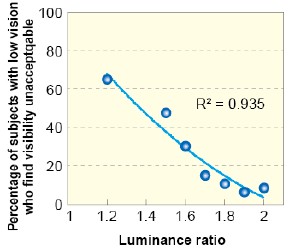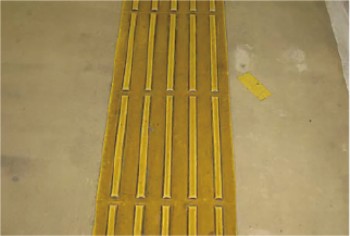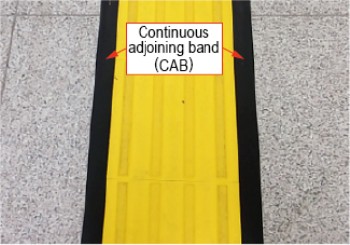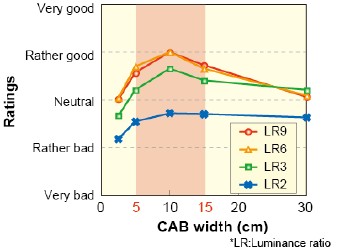27.Improvement of visibility of Tactile Walking Surface Indicators (TWSIs) for people with low vision
Visibility of tactile walking surface indicators (TWSIs) is important for people with low vision when they walk by themselves, since people with low vision, approximately 90% of the blind and vision-impaired persons, use residual vision in their independent travel. Visibility of TWSIs is determined chiefly by the luminance contrast between TWSIs and their surrounding surfaces. In this study, three investigations were conducted concerning the luminance ratio, an index of luminance contrast, between TWSIs and their surroundings, as follows.
First, the relationship between the luminance ration of TWSIs and the surrounding surfaces, and the visibility of TWSIs was examined. Forty-six people with low vision participated in this investigation. Results demonstrated the relationship between luminance ratio and the percentage of those with low vision who find the visibility of TWSIs to be unacceptable (Figure 1).
Second, some previous studies showed that when the luminance ratio is insufficient (Fig. 2), continuous adjoining bands (CAB) of dark color can be used to improve the visibility of TWSIs (Fig. 3). Some other previous studies however warn that bands of dark color on the walking surface may be falsely recognized by people with low vision as street gutters, depending on their color and/or width. Investigations were conducted to identify the optimal color and width of CABs which improve the visibility of TWSIs without being mistaken for street gutters. Forty-four people with low vision participated in this investigation. Based on the result, it was proposed to make CABs 5-15 cm wide with a luminance ratio of about 3, at least, when used with TWSIs (Figure 4).
Finally, a manual was proposed containing methods for measuring the luminance ratio between TWSIs and their surrounding surfaces, taking the environmental characteristics of railway stations into consideration.
Other Contents
- 23. Car-body tilt control system for better ride comfort
- 24.Design method and performance verification for linear rail brakes used on high-speed trains
- 25.Method for predicting passenger thermal comfort in railway vehicles
- 26.Training support program to foster resourcefulness when making PA announcements during disruptions
- 27.Improvement of visibility of Tactile Walking Surface Indicators (TWSIs) for people with low vision
- 23. Car-body tilt control system for better ride comfort
- 24.Design method and performance verification for linear rail brakes used on high-speed trains
- 25.Method for predicting passenger thermal comfort in railway vehicles
- 26.Training support program to foster resourcefulness when making PA announcements during disruptions
- 27.Improvement of visibility of Tactile Walking Surface Indicators (TWSIs) for people with low vision




